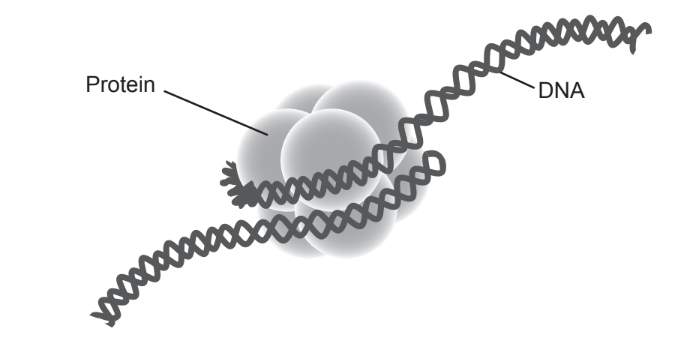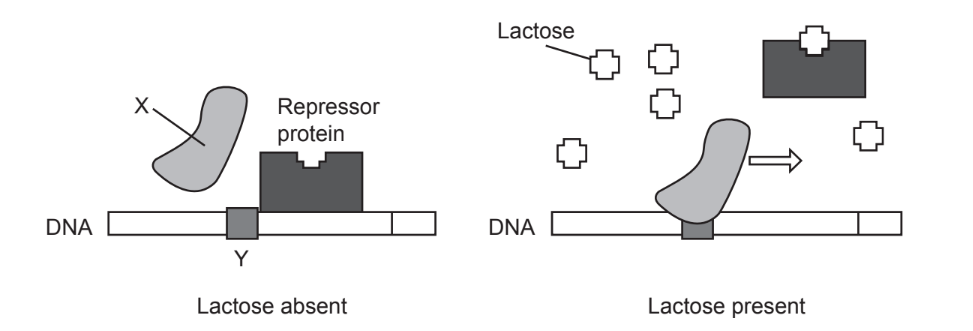Question
Outline the causes of sickle cell anemia. [2]
Answer/Explanation
Ans
a. genetic disease/caused by a gene
OR
inherited «from parents»
OR
caused by mutation «of a gene» ✔
b. base substitution
OR
GAG → GTG ✔
c. hemoglobin gene mutated / different allele/form/version of hemoglobin gene
OR
HbA → HbS ✔
d. leads to change in amino acid sequence «in hemoglobin»
OR
glutamic acid → valine ✔
e. only homozygotes have full disease/sickled cells / heterozygote has milder form
OR
hemoglobin crystallizes at low oxygen concentration ✔
f. «selected for/spreads in population» as it gives resistance to malaria ✔
Question
The biological insights of Mendel and Darwin in the 19th century remain important to this day.
a. Discuss the role of genes and chromosomes in determining individual and shared character features of the members of a species.[7]
▶️Answer/Explanation
Markscheme
Genes
a. mutation changes genes/causes genetic differences
b. genes can have more than one allele/multiple alleles
OR
alleles are different forms/versions of a gene
c. different alleles «of a gene» give different characters
OR
variation in alleles between individuals
d. eye colour/other example of «alleles of» a gene affecting a character
e. alleles may be dominant or recessive
OR
dominant alleles determine trait even if recessive allele is present
f. both alleles influence the characteristic with codominance
OR
reference to polygenic inheritance
g. all members of a species are genetically similar/have shared genes
OR
certain genes expressed in all members of a species
h. reference to epigenetics/methylation/acetylation / not all genes are expressed «in an individual»
i. genes are inherited from parents/passed on to offspring/passed from generation to generation
Chromosomes
j. same locus/same position of genes
OR
same sequence of genes/same genes on each chromosome «in a species»
k. same number of chromosomes «in a species»/all humans have 46 chromosomes/differences in chromosome number between species
l. some individuals have an extra chromosome/Down syndrome/other example of aneuploidy
OR
polyploidy divides a species/creates a new species
m. X and Y/sex chromosomes determine the sex/gender of an individual
n. meiosis/independent assortment/fertilization/sexual reproduction give new combinations «of chromosomes/genes»
a. speciation is the splitting of a species «into two species»
b. reproductive isolation/lack of interbreeding
c. isolation due to geography/«reproductive» behavior/«reproductive» timing
d. polyploidy can cause isolation
e. gene pools separated
f. differences in/disruptive selection cause traits/gene pools to change/diverge
g. gradualism / speciation/changes accumulating over long periods
h. punctuated equilibrium / speciation/changes over a short time period
a. similar structure but different function «in homologous structures»
b. pentadactyl limbs/limb with five digits/toes / other example
c. similar bone structure/example of similarity of bones «in pentadactyl limbs» but different uses/functions
d. two examples of use of pentadactyl limb by a vertebrate group
e. suggests a common ancestor «and evolutionary divergence»
f. process called adaptive radiation
Question
a. Describe the causes of Down syndrome.[5]
▶️Answer/Explanation
Markscheme
Down syndrome is caused by non-disjunction;
occurs during meiosis;
chromosome pairs fail to separate in meiosis I / chromatids in meiosis II / anaphase II;
some gametes have an extra chromosome;
can lead to zygotes/individuals with an extra chromosome / individual has 47 chromosomes;
in Down syndrome this would be trisomy 21/extra chromosome 21;
increased probability with increased age of mother/ages of parents;
skin colour is an example of polygenic inheritance;
many/more than two genes contribute to a person’s skin colour;
due to the amount of melanin in the skin;
combination of alleles determines the phenotype;
allows for range of skin colours / continuous variation of skin colour;
phenotypes do not follow simple Mendelian ratios of dominance and recessiveness;
the environment also affects gene expression of skin colour / sunlight/UV light stimulate melanin production;
the more recessive alleles there are, the lighter the skin colour; (vice versa)
c. caused by gene mutation;
(sickle-cell anemia) due to a base substitution (mutation);
changes the code on the DNA;
which leads to a change in transcription / change in mRNA;
DNA changes from CTC to CAC/GAG to GTG / mRNA changes from GAG to GUG; (accept DNA changes from CTT to CAT/GAA to GTA / mRNA changes from GAA to GUA)
which (in turn) leads to a change in translation / change in polypeptide chain/ protein;
(the tRNA) adds the wrong amino acid to the polypeptide chain;
glutamic acid replaced by valine;
produces abnormal hemoglobin;
causing abnormal red blood cell/erythrocyte shape / sickle shape;
which lowers the ability to transport oxygen;
sickle-cell allele is codominant;
homozygote/HbS HbS have sickle cell anemia/is lethal / heterozygote/HbS HbA has the sickle trait/is carrier (and is more resistant to malaria);c.
Question
The diagram shows a nucleosome from the nucleus of a eukaryotic cell.

(a) Identify the protein labelled in the diagram. [1]
(b) Outline how nucleosomes affect the transcription of DNA. [1]
The image shows the regulation of the gene responsible for producing lactase.

(c) Identify:
(i) X, the enzyme which copies a DNA sequence [1]
(ii) Y, non-coding DNA at the start of a gene. [1]
(d) Explain the role of lactose in the expression of the gene for lactase production. [3]
(e) State one reason that identical twins may show different methylation patterns as they grow older. [1]
▶️Answer/Explanation
a histone; 1
b a. (nucleosomes can) promote AND inhibit transcription of genes/expression of genes;
b. (nucleosomes can) prevent transcription by (tight) condensation/supercoiling/packing of DNA;
c. (nucleosomes can) allow/prevent binding of RNA polymerase/transcription factors;
d. tagging/acetylation/methylation of nucleosomes/histones can promote/inhibit transcription;
e. movement of histones/nucleosomes (along DNA) can affect which genes are transcribed;
c i RNA polymerase;
c ii promoter;
d a. lactose binds to repressor protein;
b. repressor protein (with lactose bound) cannot block/bind to the promoter/Y;
c. RNA polymerase/X binds to the promotor/transcribes the gene;
d. lactase produced (if lactose present)/lactase production inhibited if lactose absent;
e (different) environment/illness/disease/diet;
